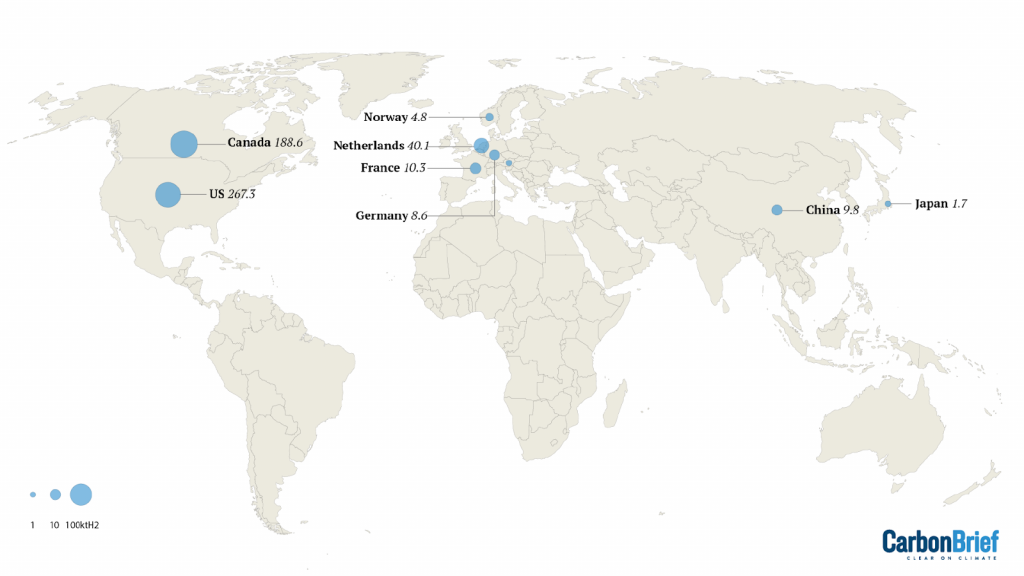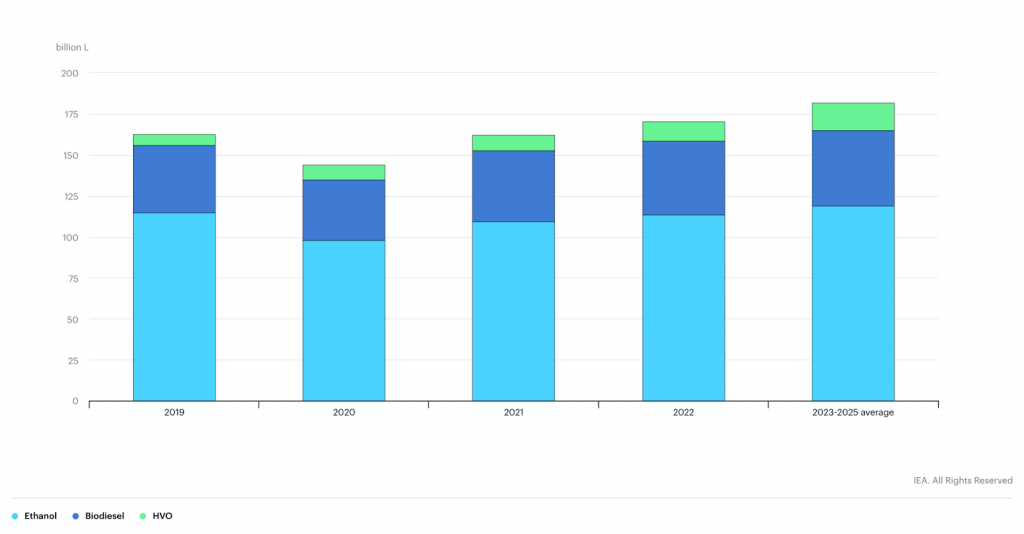Which Fuel Sources Have the Lowest Carbon Footprint? A Life-Cycle Assessment
Impactful Ninja is reader-supported. When you buy through links on our site, we may earn an affiliate commission.
Learn more
Learn more
.
Hey fellow impactful ninja ? You may have noticed that Impactful Ninja is all about providing helpful information to make a positive impact on the world and society. And that we love to link back to where we found all the information for each of our posts. Most of these links are informational-based for you to check out their primary sources with one click. But some of these links are so-called "affiliate links" to products that we recommend. First and foremost, because we believe that they add value to you. For example, when we wrote a post about the environmental impact of long showers, we came across an EPA recommendation to use WaterSense showerheads. So we linked to where you can find them. Or, for many of our posts, we also link to our favorite books on that topic so that you can get a much more holistic overview than one single blog post could provide. And when there is an affiliate program for these products, we sign up for it. For example, as Amazon Associates, we earn from qualifying purchases. First, and most importantly, we still only recommend products that we believe add value for you. When you buy something through one of our affiliate links, we may earn a small commission - but at no additional costs to you. And when you buy something through a link that is not an affiliate link, we won’t receive any commission but we’ll still be happy to have helped you. When we find products that we believe add value to you and the seller has an affiliate program, we sign up for it. When you buy something through one of our affiliate links, we may earn a small commission (at no extra costs to you). And at this point in time, all money is reinvested in sharing the most helpful content with you. This includes all operating costs for running this site and the content creation itself. You may have noticed by the way Impactful Ninja is operated that money is not the driving factor behind it. It is a passion project of mine and I love to share helpful information with you to make a positive impact on the world and society. However, it's a project in that I invest a lot of time and also quite some money. Eventually, my dream is to one day turn this passion project into my full-time job and provide even more helpful information. But that's still a long time to go. Stay impactful,Affiliate Disclosure
Why do we add these product links?
What do these affiliate links mean for you?
What do these affiliate links mean for us?
What does this mean for me personally?
![]()
Oil (including gasoline and diesel fuel) is the world’s primary fuel source for transportation. But since the turn of the century, there has been a push toward cleaner-burning transportation fuels with fewer negative effects on the environment. Different fuel sources have different carbon footprints, with some of these values being higher than others. So, we had to ask: Which fuel sources have the lowest carbon footprint?
Hydrogen, propane, algae, biodiesel, and LPG have the four highest carbon footprints of all fuel sources. They emit 0, 12.61, 5.87, 5.87, and 12.52 pounds of CO2 per gallon, respectively. They combat climate change, promote energy independence, and have various environmental benefits.
Keep reading to learn about the overall carbon footprints of these fuel sources, their carbon footprints throughout their life-cycles, and their environmental benefits and drawbacks.
Here’s How We Assessed the Carbon Footprint of All Fuel Types
The carbon footprint is one of the ways we measure the effects of human-induced global climate change. It primarily focuses on the GHG emissions associated with consumption, but also includes other emissions such as methane (CH4), nitrous oxide, and chlorofluorocarbons.
“Carbon footprint: the amount of greenhouse gases and specifically carbon dioxide emitted by something (such as a person’s activities or a product’s manufacture and transport) during a given period”
Merriam Webster
Basically, it is the amount of carbon emitted by an activity or an organization. This includes GHG emissions from fuel that we burn directly (e.g., heating a home, driving a car) and GHG emissions from manufacturing the products that we use (e.g., power plants, factories, and landfills).
To understand the carbon footprint of all fuel types, we must assess their life-cycle and each stage’s carbon footprint. This life-cycle assessment (LCA) is a method to evaluate the environmental impacts of products and materials. Over the years, companies have strategically used LCA to research and create more sustainable products. So, we had a look at the LCA for all of the fuel types! (No worries, we’ll link back to each throughout this article.)
These 4 Fuel Sources Have the Lowest Carbon Footprint
When discussing the carbon footprint of certain fuel sources, we must take into account carbon emissions across the fuel’s building, extracting, transportation, and building back phases.
| Type of Fuel | Carbon Footprint |
| Hydrogen | 0 pounds (lb) CO2 per gallon |
| Biodiesel | 5.87 lb CO2 per gallon |
| Algae | ~5.87 lb CO2 per gallon (comparable to biodiesel) |
| LPG | 12.52 lb CO2 per gallon |
| Propane | 12.61 lb CO2 per gallon |
Oil is still the world’s primary fuel source for transportation. The transportation sector was valued at $5,938.6 billion in 2020 and is expected to reach $7,500.8 billion in 2023. But alternative fuels have become increasingly widespread as the world looks to mitigate climate change.
In 2020, ten governments adopted H2 strategies: Canada, Chile, France, Germany, the Netherlands, Norway, Portugal, Russia, Spain and the European Union. And in 2021, four more joined the mix: Czech Republic, Colombia, Hungary, and the United Kingdom.

Global biofuel production in 2019 was 156 billion liters (bl), and this number is expected to increase to 165 bl in 2025.

The share of LPG in total fuel consumption ranges from 0.03% in the United States to over 20% in Ukraine.

The total carbon footprint of H2, biodiesel, algae, LPG, and propane fuel would equal the carbon footprint from building + the carbon footprint from extracting + the carbon footprint from transportation + the carbon footprint from building back.
Hydrogen Fuel Has the Lowest Carbon Footprint at 0 Pounds of CO2 Emitted Per Gallon
Hydrogen (H2) is a colorless, odorless, tasteless, flammable gas and is the most abundant element in the universe. Vehicles that are powered by H2 are called fuel cell electric vehicles (FCEV). In FCEVs, the energy stored in H2 is converted to electricity by a fuel cell.
“Hydrogen: a chemical element that is the lightest gas, has no color, taste, or smell, and combines with oxygen to form water”
Cambridge Dictionary
H2 fuel still comes with emissions, albeit not directly. Sourcing H2 from NG produces approximately 830 million tons of CO2 every year, which is equivalent to the emissions of the United Kingdom and Indonesia combined. But since fuel cells in FCEVs only emit water and warm air as exhaust, H2 fuel is considered clean-burning and has zero emissions.
Here are the life-cycle stages of H2 fuel and each stage’s carbon footprint:
- Building of H2 fuel: CO2 emissions from building the components of the steam-methane reforming plants
- Extraction of H2 fuel: CO2 emissions from thermal, electrolytic, solar-driven, and biological processes
- Transportation of H2 fuel: CO2 emissions from transporting H2 by barges, tankers, pipelines, trucks, and railroads across distances
- Building back of H2 fuel: CO2 emissions from utilizing construction equipment to demolish the buildings and construct new buildings in the old steam-methane reforming plants’ place
Establishing H2 as a mainstream transportation fuel has been difficult and expensive. To date, H2 makes up less than 0.01% of all energy consumed. Although there were 40,000 FCEVs on the road in June of 2021, this totaled less than 0.01% of global total vehicles and less than 0.03% of total electric vehicles. But spurred by developments in the United States and in Asia, the H2 fuel market is expected to increase from $651.9 million in 2018 to $42,038.9 million, by 2026.
Biodiesel Has the Joint Second-Lowest Carbon Footprint at 5.87 Pounds of CO2 Emitted Per Gallon
Biodiesel is an alternative, cleaner-burning fuel than petroleum-based diesel fuel (petroleum diesel). It is a subset of biofuels (ethanol and biodiesel) that is made from biomass. Biomass is renewable organic material from plants and animals that can be used to produce a wide range of products including energy, everyday products that contain plastics, and fuel.
“Biodiesel: a type of fuel made from plant or animal material and used in diesel engines”
Oxford Dictionary
Like petroleum diesel, biodiesel is used in diesel engines, which use compressed air in a cylinder to ignite the fuel rather than a spark. Biodiesel can be blended with petroleum diesel in any percentage to produce finished biodiesel. Pure biodiesel is referred to as B100, and B20 (20% biodiesel and 80% petroleum diesel) is the most common blend.
Here are the life-cycle stages of biodiesel and each stage’s carbon footprint:
- Building of biodiesel: CO2 emissions from building the components of the biorefinery
- Extraction of biodiesel: CO2 emissions from the transesterification process
- Transportation of biodiesel: CO2 emissions from transporting biodiesel by barges, tankers, pipelines, trucks, and railroads across distances
- Building back of biodiesel: CO2 emissions from utilizing construction equipment to demolish the buildings and construct new buildings in the old biorefinery’s place
One gallon of biodiesel produces 74% fewer emissions than petroleum diesel, and B20 can reduce emissions from carbon monoxide (CO) by 12.6%, hydrocarbons 11%, particulates 18%, and air toxics 12-20%. Depending on the source and scale of biodiesel, it can be an environmentally friendly alternative to petroleum diesel that can help mitigate the effects of global climate change. This is one reason why the biodiesel market is expected to increase from $141 billion in 2020 to $307 billion by 2030.
Algae Fuel Has the Joint Second-Lowest Carbon Footprint at Approximately 5.87 Pounds of CO2 Emitted Per Gallon
Algae fuel, also known as algal biofuel, is a type of biofuel that is produced from algae. Algae are organisms capable of existing in both marine (saltwater) and freshwater environments. They are the food base for almost all aquatic life and are sources of food, crude oil, and pharmaceutical/industrial products for humans.
“Algae fuel, algal biofuel, or algal oil: an alternative to liquid fossil fuels that uses algae as its source of energy-rich oils”
Wikipedia
The three main pathways to produce biofuels from algae are vegetable oil, carbohydrates, and biomass. The vegetable oil pathway is the most common because algae produce triglycerol during photosynthesis, which is the right kind of oil required to make biodiesel. Although the CO2 emission values for algal fuel are not well known, the numbers for biodiesel – which is largely produced with algae’s biomass – have been established. And we can use these numbers to get an emissions approximation for algal fuel.
Here are the life-cycle stages of algal fuel and each stage’s carbon footprint:
- Building of algal fuel: CO2 emissions from building the components of the algal farm
- Extraction of algal fuel: CO2 emissions from either the transesterification or fermentation process
- Transportation of algal fuel: CO2 emissions from transporting algal fuel by barges, tankers, pipelines, trucks, and railroads across distances
- Building back of algal fuel: CO2 emissions from utilizing construction equipment to demolish the algal farm systems and construct new infrastructure in the old system’s place
Although algae fuel does not currently occupy a large space in the fuel market, the market for algal fuel is expected to increase from $6.8 billion (b) to $11.4 b by the year 2027.
LPG Has the Third-Lowest Carbon Footprint at 12.52 Pounds of CO2 Emitted Per Gallon
LPG, also known as liquified petroleum gas, refers to 2 natural gas liquids: propane and butane. Or a mixture of the two. Propane and butane are by-products of natural gas (NG) processing and crude oil refining. Although they are chemically very similar, minute differences make propane and butane suited for different applications. Liquid components recovered during NG processing include ethane, methane, propane, and butane, and heavy hydrocarbons. Liquid components recovered during oil refining include propane, butane, and other gases.
“LPG (liquefied petroleum gas): a type of fuel used for heat, cooking, and in some vehicles”
Cambridge Dictionary
As a transportation fuel, LPG is referred to as autogas. It is the #1 unblended alternative fuel in the world, with more than 25 countries promoting its use. Autogas powers roughly 27 million vehicles globally, and global consumption has increased by 40% in the past decade.
Here are the life-cycle stages of LPG and each stage’s carbon footprint:
- Building of LPG: CO2 emissions from construction of oil-fired plants and NG power plants
- Extraction of LPG: CO2 emissions from oil extraction/refinement and NG extraction/processing
- Transportation of LPG: CO2 emissions from transporting LPG by barges, tankers, pipelines, trucks, and railroads across distances
- Building back of LPG: CO2 emissions from utilizing construction equipment to demolish the buildings and construct new buildings in the old oil-fired or NG plant’s place
Per gallon upon combustion, propane emits only 12.61 lb and butane emits only 14.7 lb per gallon. As a whole, LPG emits only 12.52 lb of CO2 per gallon. This is one major reason the LPG market is expected to increase from $130.1 billion (B) in 2020 to $243.4B by 2030.
Propane Has the Fourth-Lowest Carbon Footprint at 12.61 Pounds of CO2 Emitted Per Gallon
Propane, also known as liquified petroleum gas (LPG), is a gaseous, alternative, cleaner-burning fuel used in light-, medium-, and heavy-duty propane vehicles. Propane is a by-product of natural gas (NG) processing and crude oil refining. Liquid components recovered during NG processing include ethane, methane, propane, and butane, and heavy hydrocarbons. Liquid components recovered during oil refining include propane, butane, and other gases.
“Propane: a heavy flammable gaseous alkane C3H8 found in crude petroleum and natural gas and used especially as fuel and in chemical synthesis”
Merriam-Webster Dictionary
Propane can only be used in propane-specific vehicles (shuttles, police vehicles, school buses) in the form of HD-5, which consists of at least 90% propane and no more than 5% propylene and 5% other gases (butane and butylene). It is stored inside vehicles in pressurized (100-200 psi) tanks, which causes the gas to condense into a liquid. Propane has a higher octane rating than gasoline, meaning it is more stable and resistant to engine knocking. But it also has a lower Btu rating, so it takes more fuel by volume to drive the same amount of miles.
Here are the life-cycle stages of propane and each stage’s carbon footprint:
- Building of propane: CO2 emissions from construction of oil-fired plants and NG power plants
- Extraction of propane: CO2 emissions from oil extraction/refinement and NG extraction/processing
- Transportation of propane: CO2 emissions from transporting propane by barges, tankers, pipelines, trucks, and railroads across distances
- Building back of propane: CO2 emissions from utilizing construction equipment to demolish the buildings and construct new buildings in the old oil-fired or NG plant
Propane emits only 12.61 lb per gallon of fuel combusted. Because of its availability, energy density, clean-burning qualities, and low cost, propane is the world’s third most common transportation fuel. It is surpassed only by gasoline and diesel fuel in terms of widespread usage. The propane market is expected to increase from $126.5 billion (B) in 2020 to $146.7B by 2027.
What Roles Do The Fuel Sources With the Lowest Carbon Footprint Play in Combating Climate Change
Climate change is arguably the most severe, long-term, global impact of fossil fuel combustion. Every year, approximately 36 billion tons (bt) of CO2 are emitted from burning fossil fuels. The carbon found in fossil fuels reacts with oxygen in the air to produce CO2 which warms the earth by acting as a heating blanket.
“Climate Change: changes in the world’s weather, in particular the fact that it is believed to be getting warmer as a result of human activity increasing the level of carbon dioxide in the atmosphere:”
Cambridge Dictionary
Reduced CO2 emissions from H2, biodiesel, algae, LPG, and propane combat climate change in the following ways:
- Increasing temperatures: Earth’s atmosphere has warmed 1.5 degrees Celsius (C) since 1880. This may not seem like a lot, but these degrees create regional and seasonal temperature extremes, reduce sea ice, intensify rainfall and drought severity, and change habitat ranges for plants and animals.
- Rising sea levels: Global sea levels have increased approximately 8-9 inches since 1880, displacing people living along coastlines and destroying coastal habitats. Roads, bridges, subways, water supplies, oil and gas wells, power plants, sewage treatment plants, and landfills remain at risk if sea level rise goes unchecked.
- Melting of sea ice: Since 1979 arctic sea ice has declined by 30%. Sea ice plays a major role in regulating the earth’s climate by reflecting sunlight into space and providing habitat for animal species. If all of the glaciers on Earth melted, sea levels would rise by approximately 70 feet, effectively flooding out every coastal city on the planet.
- Changing precipitation patterns: Extreme weather events (e.g., hurricanes, floods, droughts) are becoming more common and more intense. Storm-affected areas will experience increased precipitation and flooding whereas areas located further from storm tracks will experience decreased precipitation and droughts.
- Ocean acidification: The ocean absorbs 30% of the CO2 released into the atmosphere, which decreases the pH (increases the acidity) of the ocean. In the past 200 years, the pH of oceans has decreased by 0.1 pH units, which translates to a 30% increase in acidity. Aquatic life unable to adjust to this rapid acidification will die off. A prime example of this is coral bleaching, where coral expel the algae (zooxanthellae) living in their tissues as a result of changes in temperature, light, or nutrients.
Climate change results in global warming, when CO2 and other air pollutants absorb sunlight and solar radiation in the atmosphere, thereby trapping the heat and acting as an insulator for the planet. Since the Industrial Revolution, Earth’s temperature has risen a little more than 1 degree Celsius (C), or 2 degrees Fahrenheit (F). Between 1880-1980 the global temperature rose by 0.07C every 10 years. This rate has more than doubled since 1981, with a current global annual temperature rise of 0.18C, or 0.32F, for every 10 years.
Experts claim that to avoid a future plagued by rising sea levels, acidified oceans, loss of biodiversity, more frequent and severe weather events, and other environmental disasters brought on by the hotter temperatures, we must limit global warming to 1.5C by 2040.
The more we reduce CO2 emissions, the more we slow the rate of temperature rise, sea-level rise, ice melting, and ocean acidification. When these rates are slowed, the earth’s biodiversity does not have to struggle to adapt to temperature and pH changes. People will not be displaced due to the flooding of coastal areas. And icebergs will continue to provide climate regulation.
How Environmentally Friendly Are The Fuel Sources With the Lowest Carbon Footprint
The overall environmental friendliness of a fuel source depends on which fuel source is being discussed.
“Environmentally friendly: (of products) not harming the environment.”
Cambridge Dictionary
There are collective, as well as unique, benefits and drawbacks to each fuel source. The four fuel sources with the lowest carbon footprint have lower levels of CO2 emissions and numerous environmental benefits as a result.
What Are the Environmental Benefits of The Fuel Sources With the Lowest Carbon Footprint
All four fuel types have the following environmental benefits:
- Climate change mitigation: The above-mentioned fuel sources emit less CO2 and GHG emissions than traditional fossil fuels. This reduction in emissions, in turn, reduces the effects of global climate change including increasing temperatures, rising sea levels, melting of sea ice, changing precipitation patterns, and ocean acidification.
- Energy independence: Being able to produce our own electricity in the US without the aid of foreign countries is an important step to help us become more self-sufficient. Former President George W. Bush signed the Energy Independence and Security Act of 2007 to reduce U.S. dependence on oil, expand the production of renewable fuels (and confront global climate change).
Propane and LPG also eliminate oil spills and eliminate fugitive emission impacts. In the event of an oil spill, propane and LPG quickly evaporate into the atmosphere. This means they will not leach into and contaminate the surrounding soil. Because they are not a GHG, propane and LPG will not negatively harm the environment if they are released into the atmosphere prior to combustion. On the other hand, NG is composed mostly of CH4, which has a global warming potential 25 times that of CO2. If it is released into the atmosphere before combustion, NG will accelerate the global warming process.
There are also specific benefits unique to these three fuel sources:
- Hydrogen (H2): H2 produces few waste products because water and warm air are the only waste products associated with the chemical reaction inside a fuel cell. It is also versatile and can be sourced from renewable energy, coal, oil, NG, and nuclear power. It can be transported by pipeline, ship, or plane and can be used as electricity or transportation fuel.
- Biodiesel: Biodiesel yields 93% more energy than the energy used in its production. Its production, compared to petroleum diesel production, also reduces wastewater by up to 79%. Biodiesel is non-toxic, biodegradable, and can reduce hazardous waste by up to 96%. It will degrade quicker in the case of an oil spill, and it will not cause as many environmental problems compared to petroleum diesel. It also degrades when it comes into contact with water.
- Algae: Algae comprise less than 2% of global carbon, yet they can absorb and fix up to 50% of atmospheric CO2, which equates to between 30 and 50 billion metric tons per year). They also produce 50% of global O2 through photosynthesis. Because algae can be grown using salt or brackish water instead of on land, it does not displace farmland needed to grow crops and does not cause deforestation. Algae have the potential to generate a minimum of 30 times more energy when compared to the land-based crops currently used to produce biofuels. Algae can also be grown in both wastewater and saltwater, which reduces the demand and competition for limited freshwater supplies.
What Are the Environmental Drawbacks of The Fuel Sources With the Lowest Carbon Footprint
Each fuel source comes with its own set of environmental drawbacks that should be taken into account when discussing its carbon footprint.
- Hydrogen (H2): H2 fuel still comes with emissions, albeit not directly. Sourcing H2 from NG produces approximately 830 million tons of CO2 every year, which is equivalent to the emissions of the United Kingdom and Indonesia combined. NG is currently the top provider of H2, and 7.5 billion tons of CO2 every year occur because of NG combustion. Although the CO2 emissions from the combustion of NG are about 50%-60% less than those from coal and oil, the primary component of NG is CH4, a gas 34 times stronger at trapping heat than CO2 over 100 years. This means that a little CH4 can go a long way when contributing to global warming.
- Biodiesel: If made from unused cooking oil (canola, soybean, palm), biodiesel comes with environmental drawbacks. In some parts of the world, large swaths of forests have been cleared and burned to plant soybeans and palm trees. Dedicating land for the sole purpose of biofuel production leads to deforestation, which occurs at roughly 10 million hectares (~ 25 million acres) per year. Protecting forest habitats increases carbon sequestration and decreases the effects of global climate change.
- Algae: One environmental drawback associated with algae fuel is electricity usage. Growing algae requires a large amount of energy to pump the water and stir the algal broth, and this energy is primarily generated from fossil fuels. Fossil fuel combustion releases toxic chemicals, heavy metals, CO2, and contributes directly to global warming. Also, algae need to be fertilized with nitrogen and phosphorus as they grow, the production and application of which generates emissions.
Although they are cleaner burning, propane and LPG are still derived from fossil fuels. To extract propane and LPG you must first extract oil and NG, a process that comes with the following environmental drawbacks.
- Drilling: This can disturb vegetation and soil and may require clearing and leveling the area around a well pad. Drilling also produces air pollution and may contaminate water sources via erosion, fracking fluids, equipment runoff, and sedimentation.
- Landscape alterations: Drilling for NG causes surface distribution from drill pads, roads, and pipelines that alter the landscape. Fragmentation of wildlife habitat and migration patterns have also been documented.
- Water pollution: Land clearing may cause dirt, minerals, and other pollutants to erode into nearby waterways. Drinking water may become contaminated with hazardous chemicals via drilling, fracturing, processing, and refining the gas, and wastewater disposal.
Final Thoughts
H2, biodiesel, algae, LPG, and propane have the lowest carbon footprints across their building, extracting, transportation, and building back phases compared to all other fuel sources. They combat global warming with their low levels of CO2 emissions and promote energy independence. Our atmosphere and Earth’s biota benefit when we use these fuel sources instead of traditional fossil fuels.
Carbon emissions have devastating effects on the environment. Reducing our carbon footprint is important because it mitigates the effects of climate change, which has a positive cascade effect on public health and plant and animal diversity. It also leads to more environmentally-friendly solutions.
Stay impactful,

Sources
- Environmental and Energy Study Institute: Fossil Fuels
- Britannica: Carbon Footprint
- United States Environmental Protection Agency: System of Registries
- Science Direct: Life-cycle assessment (LCA)
- MIT SMR: Strategic Sustainability Uses of Life-Cycle Analysis
- Impactful Ninja: What Is the Carbon Footprint of Hydrogen?
- Impactful Ninja: What Is the Carbon Footprint of Biodiesel?
- Impactful Ninja: What Is the Carbon Footprint of Algae Fuel?
- Impactful Ninja: What Is the Carbon Footprint of LPG?
- Impactful Ninja: What Is the Carbon Footprint of Propane?
- International Energy Agency: Global biofuel production in 2019 and forecast to 2025
- World LPG Association: The Autogas Market
- GlobeNewsWire: Global Transport Market Report (2020 to 2030) – COVID-19 Impact and Recovery
- US Department of Energy Efficiency and Renewable Energy: Alternative Fuels Data Center – Fuel Cell Electric Vehicles
- US Environmental Protection Agency: Greenhouse Gas Emissions from a Typical Passenger Vehicle
- US Environmental Protection Agency: Emission Factors for Greenhouse Gas Inventories
- US Energy Information Administration: Carbon Dioxide Emissions Coefficients by Fuel
- International Energy Association: Hydrogen
- International Energy Association: The Future of Hydrogen
- Office of Energy Efficiency and Renewable Energy: Hydrogen Fuel Basics
- US Department of Energy Efficiency and Renewable Energy: Alternative Fuels Data Center – Hydrogen Production and Distribution
- Union of Concerned Scientists: How Clean Are Hydrogen Fuel Cell Electric Vehicles?
- Allied Market Research: Hydrogen Fuel Cell Market
- Biodiesel: Biodiesel basics
- US Energy Information Administration: Biomass Explained
- Office of Energy Efficiency and Renewable Energy: Biofuel basics
- Merriam-Webster Dictionary: Biorefinery
- European Technology and Innovation Platform: Transesterification to biodiesel
- Canary USA: Are the Stresses of Middle Age Too Much for Today’s Refineries?
- GlobeNewswire: Biofuels Market Size Worth Around US$ 307.01 Billion by 2030
- Biotechnology Innovation Organization: Biofuels – The Promise of Algae
- Bioenergy: What are Biofuels?
- Britannica: Algae
- Farm Energy: Algae for Biofuel Production
- Britannica: Fermentation
- Business Wire: Global Algae Biofuels Market Report 2021 – Market to Reach $11.4 Billion by 2027
- World LPG Association: What is LPG?
- World LPG Association: Autogas
- American Petroleum Institute: Refinery Processes
- Propane: How is Propane Distributed?
- GlobeNewswire: Liquefied Petroleum Gas (LPG) Market To Reach $243.4 Billion by 2030
- US Department of Energy – Alternative Fuels Data Center: Propane Fuel Basics
- US Department of Energy – Alternative Fuels Data Center: Propane Production and distribution
- University of Wisconsin-Stevens Point: Facts about Propane
- US Energy Information Administration: Gasoline Explained – Octane in Depth
- Coloradans for Responsible Energy Development: The seven steps of oil and natural gas extraction
- Coloradans for Responsible Energy Development: How long does fracking last?
- GlobeNewswire: Global Propane Market Outlook to 2027 – Residential Propane Projected to Record a 2.5% CAGR and Reach $15 Billion
- World Nuclear Association: Carbon Dioxide Emissions from Electricity
- The National Wildlife Federation: Climate Change
- National Oceanic and Atmospheric Administration: Climate Change – Global Temperature
- National Oceanic and Atmospheric Administration: Climate Change – Global Sea Level
- United States Geological Survey: How would sea level change if all glaciers melted?
- National Aeronautics and Space Administration, U.S.A.: How does climate change affect precipitation?
- National Oceanic and Atmospheric Administration: Ocean Acidification
- National Ocean Service: What is coral bleaching?
- National Resources Defense Council: Global Warming 101
- United Nations Framework Convention on Climate Change: The Paris Agreement
- International Energy Association: The Future of Hydrogen
- Union of Concerned Scientists: Environmental Impacts of Natural Gas
- The Guardian: Biofuels are not a green alternative to fossil fuels
- Food and Agricultural Organization of the United States: State of the World’s Forests 2020
- One Green Planet: How Saving Wildlife Benefits Humans – In Ways We Really Need
- IEEE Spectrum: New tech could turn algae into the climate’s slimy savior
- Office of Energy Efficiency and Renewable Energy: Algal Production
- United States Geologic Survey: Landscape Effects of Oil and Gas Development
- White House Archives: Fact Sheet – Energy Independence and Security Act of 2007
- United States Environmental Protection Agency: Summary of the Energy Independence and Security Act
- Carbon Brief: In-depth Q&A – Does the world need hydrogen to solve climate change?




